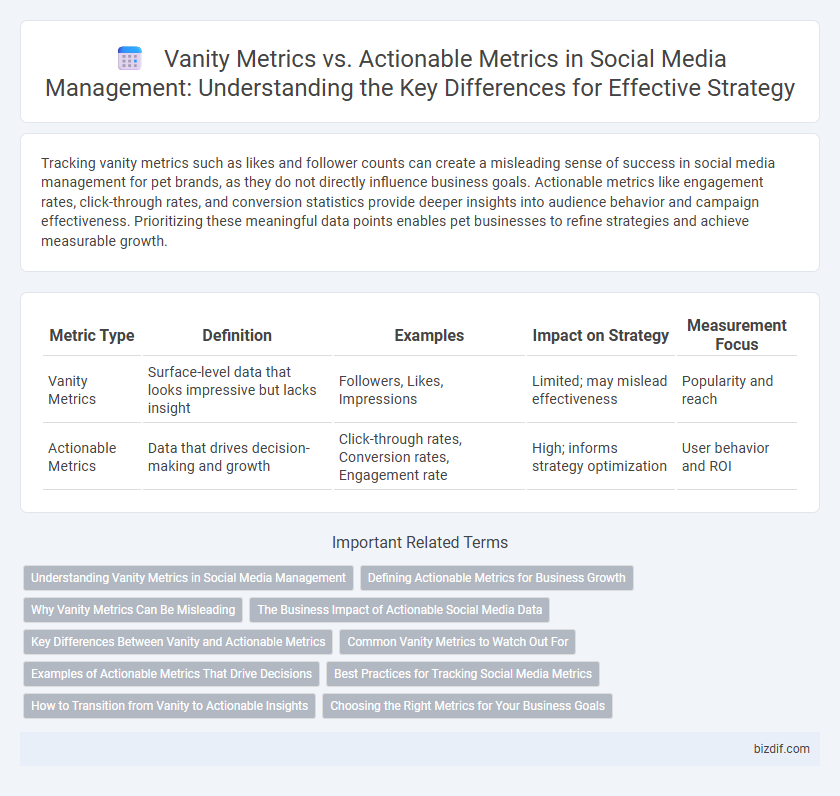Tracking vanity metrics such as likes and follower counts can create a misleading sense of success in social media management for pet brands, as they do not directly influence business goals. Actionable metrics like engagement rates, click-through rates, and conversion statistics provide deeper insights into audience behavior and campaign effectiveness. Prioritizing these meaningful data points enables pet businesses to refine strategies and achieve measurable growth.
Table of Comparison
| Metric Type | Definition | Examples | Impact on Strategy | Measurement Focus |
|---|---|---|---|---|
| Vanity Metrics | Surface-level data that looks impressive but lacks insight | Followers, Likes, Impressions | Limited; may mislead effectiveness | Popularity and reach |
| Actionable Metrics | Data that drives decision-making and growth | Click-through rates, Conversion rates, Engagement rate | High; informs strategy optimization | User behavior and ROI |
Understanding Vanity Metrics in Social Media Management
Vanity metrics in social media management include likes, followers, and impressions that may appear impressive but do not directly correlate with meaningful business outcomes. These metrics often create a false sense of success, diverting focus from engagement rates, click-throughs, and conversions that drive strategic decision-making. Understanding the limitations of vanity metrics is crucial for optimizing content strategies and achieving tangible growth in audience interaction and ROI.
Defining Actionable Metrics for Business Growth
Actionable metrics in social media management are data points directly tied to specific business objectives, such as conversion rates, click-through rates, and customer acquisition costs, which provide clear insights for strategic decision-making. Unlike vanity metrics--such as likes, followers, and impressions--actionable metrics drive measurable growth by identifying what content and campaigns are effectively influencing user behavior. Prioritizing actionable metrics enables businesses to optimize social media strategies, improve return on investment (ROI), and achieve sustainable growth.
Why Vanity Metrics Can Be Misleading
Vanity metrics, such as likes and follower counts, can be misleading because they often inflate perceived success without demonstrating real engagement or conversion. These metrics fail to provide insight into user behavior, purchase decisions, or content effectiveness, which are critical for strategic social media management. Actionable metrics like click-through rates, conversion rates, and engagement quality offer measurable data that drive informed marketing decisions and business growth.
The Business Impact of Actionable Social Media Data
Actionable social media metrics such as engagement rate, click-through rates, and conversion rates provide direct insights into audience behavior and campaign effectiveness, driving informed business decisions. Unlike vanity metrics like follower count or likes, actionable data reveals the true impact on sales growth, brand loyalty, and customer retention. Prioritizing these metrics enables businesses to optimize social media strategies for measurable ROI and sustainable competitive advantage.
Key Differences Between Vanity and Actionable Metrics
Vanity metrics such as follower counts and likes offer superficial insights that do not directly influence business goals, while actionable metrics like conversion rates and engagement quality directly correlate with marketing success and ROI. Vanity metrics are easy to manipulate and often lead to misinformed decisions, whereas actionable metrics provide measurable outcomes that guide strategic adjustments in social media campaigns. Understanding the distinction between these metrics helps prioritize data that drives meaningful customer interactions and revenue growth.
Common Vanity Metrics to Watch Out For
Common vanity metrics to watch out for in social media management include follower count, likes, and impressions, which often inflate perceived success without indicating genuine engagement or conversion. These numbers can be misleading as they do not measure audience quality or the effectiveness of content in driving business goals. Prioritizing actionable metrics such as click-through rates, conversion rates, and engagement quality provides deeper insights into campaign performance and return on investment.
Examples of Actionable Metrics That Drive Decisions
Engagement rate, click-through rate (CTR), and conversion rate are key actionable metrics in social media management that directly influence strategic decisions by revealing audience interaction and content effectiveness. Monitoring follower growth alongside average session duration helps identify which campaigns retain user attention and foster meaningful connections. Tracking cost per acquisition (CPA) and customer lifetime value (CLV) provides insights into the return on investment (ROI) of social media efforts, enabling marketers to optimize budget allocation for higher impact.
Best Practices for Tracking Social Media Metrics
Tracking actionable metrics such as conversion rates, click-through rates, and engagement quality provides more strategic insights than vanity metrics like follower counts and likes, which often inflate perceived success without driving business goals. Best practices for social media management emphasize setting clear objectives, using tools like Google Analytics and native platform insights, and continuously analyzing key performance indicators (KPIs) aligned with campaign goals. Prioritizing actionable data enables more effective resource allocation and optimization of content strategies for tangible ROI improvements.
How to Transition from Vanity to Actionable Insights
Shifting from vanity metrics like likes and followers to actionable metrics involves identifying key performance indicators (KPIs) tied to business goals such as conversion rates, engagement quality, and customer retention. Implement tools like social media analytics platforms to track meaningful interactions, click-through rates, and lead generation data, enabling data-driven decision-making. Regularly analyze audience behavior and campaign outcomes to refine strategies that drive measurable growth and return on investment (ROI).
Choosing the Right Metrics for Your Business Goals
Vanity metrics such as likes and follower counts can create a misleading sense of success without driving business growth, whereas actionable metrics like conversion rates, engagement quality, and customer acquisition cost directly impact strategic decisions. Selecting metrics aligned with your business objectives ensures resources focus on measurable outcomes that improve ROI and customer retention. Prioritizing KPIs that reflect meaningful user behavior optimizes social media management for sustained performance.
Vanity metrics vs Actionable metrics Infographic

 bizdif.com
bizdif.com